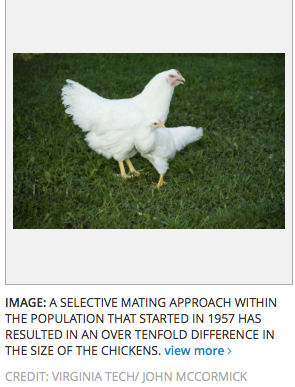More “settled science.”
The media release is below.
###
Chicken study reveals evolution can happen much faster than thought
New study of chickens overturns the popular assumption that evolution is only visible over long time scales
UNIVERSITY OF OXFORD

A new study of chickens overturns the popular assumption that evolution is only visible over long time scales. By studying individual chickens that were part of a long-term pedigree, the scientists led by Professor Greger Larson at Oxford University’s Research Laboratory for Archaeology, found two mutations that had occurred in the mitochondrial genomes of the birds in only 50 years. For a long time scientists have believed that the rate of change in the mitochondrial genome was never faster than about 2% per million years. The identification of these mutations shows that the rate of evolution in this pedigree is in fact 15 times faster. In addition, by determining the genetic sequences along the pedigree, the team also discovered a single instance of mitochondrial DNA being passed down from a father. This is a surprising discovery, showing that so-called ‘paternal leakage’ is not as rare as previously believed. The study is published in the online early version of the journal, Biology Letters.
Using a well-documented 50-year pedigree of a population of White Plymouth Rock chickens developed at Virginia Tech by Professor Paul Siegel, the researchers reconstructed how the mitochondrial DNA passed from mothers to daughters within the population. They did this by analysing DNA from the blood samples of 12 chickens of the same generation using the most distantly related maternal lines, knowing that the base population had started from seven partially inbred lines. A selective mating approach within the population started in 1957, resulting in what is now an over tenfold difference in the size of the chickens in the two groups when weighed at 56 days old.
Senior author Professor Larson said: ‘Our observations reveal that evolution is always moving quickly but we tend not to see it because we typically measure it over longer time periods. Our study shows that evolution can move much faster in the short term than we had believed from fossil-based estimates. Previously, estimates put the rate of change in a mitochondrial genome at about 2% per million years. At this pace, we should not have been able to spot a single mutation in just 50 years, but in fact we spotted two.’
The paper says there is now considerable evidence of a disparity between long-term and short-term estimates of mitochondrial changes. One theory put forward in recent studies is that mitochondrial DNA evolves ‘non-neutrally’, that there is a purifying selection process and negative mutations are removed more quickly, resulting in the impression of a short-term elevation in rates. There have been few studies of short-term mitochondrial evolution, including both mutation rates and paternal leakage. There is now direct evidence that it is not always inherited from the mother.
Study lead author Dr Michelle Alexander, from the University of York, said: ‘The one thing everyone knew about mitochondria is that it is almost exclusively passed down the maternal line, but we identified chicks who inherited their mitochondria from their father, meaning so-called ‘paternal leakage’ can happen in avian populations. Both of these findings demonstrate the speed and dynamism of evolution when observed over short time periods.’
###
They’re still chickens, not having reverted into dinosaurs, so this is emphatically NOT evolution (the biggest hoax of all time – global warming is only #2), but merely variation within a kind. Nothing to see here, folks.
This is a result of selective breeding – decidedly not ‘natural selection’ or Darwinian evolution.
A better example is the apple maggot fly, which naturally ‘evolved’ from the (strictly American) Hawthorn maggot fly after apples were introduced to North America – sometime between 1800 and 1850.
The flies are now separate species, incapable of interbreeding.
What moron would think that a change in the frequency of a alleles is a population, is, as in actually IS, Evolution?
Oh, right. “Scientists.” Forgot about all those Retards In White: used to be that people in white locked them kind of stupid up… but then The Stupids took over the Asylum Of Science, and now they are in charge.
University of Oxford, no less, too. Stupid as little pebbles, they are, yes indeed.
Yup, previous research, ignored by most consensus scientists, showed the mutations were more common and much faster than thought. Why was that research ignored?? Because it takes away the possibility of the human genome being millions or even hundreds of thousands of years old…
It also starts one wondering yet again where all the transitional forms are today, not too mention in the stratigraphic pile.
Adapt of die.
What all junk scientists want to know is:
1. Do the bigger chickens TASTE better and;
2. Who will be brave enough to eat them, knowing they are G.M.